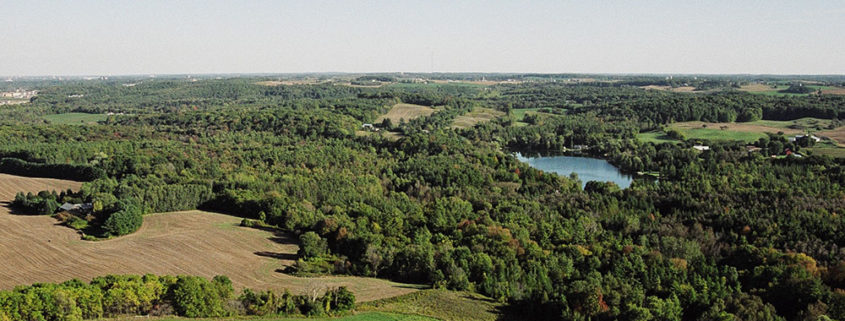Meromictic Lake
Sunfish Lake is a small meromictic kettle lake located in the North-East corner of the Township of Wilmot, Region of Waterloo, Province of Ontario. It is a private lake wholly owned by the abutting property owners and, indeed, the property owners own the land covered by water personally or through their holding company unlike most of the lakes in Ontario.
The zoning is a mix of permanent year-round and seasonal usage. As it is located within a half a mile of the North-Westerly corner of the City of Waterloo and thus the large urban centre of Kitchener -Waterloo it is amazingly rural and bucolic. Indeed it is cherished by those who live there. The owners have agreed that there will be no motorized water-craft beyond small electric trolling motors and a Green Ecology without fertilizers or pesticides and such good practices as regular pump-outs and inspections of septic systems. Other small lakes in the area such as Paradise and Puslinch are bigger non-meromictic and used year round. They are also accessible by public roads.
There are 20 properties fronting on the lake and with the exception of those fronting on the public road at the southern end of the lake (Berletts Road ) all of the properties are accessed only by private roads. With the exception of a few, all are zoned seasonal use. Many are being upgraded now and could be used year long with foundations, insulation and improved septic systems and wells rather than using lake water.
In addition to non-power water sports like swimming and diving, canoeing, rowing in the summer there are those who fish (largely catch and release) of who have simple catamarans with small electric motors to drift around the lake . In winter there is skating on cleared areas, cross country skiing and snow shoeing and if you need exercise plenty of snow shoveling to keep the roads open. There are no power boats as they are too noisy and cause safety problems for swimmers and no hunting etc. as the zoning doesn’t permit it. Sailing of sunfish and other small craft is OK but the fact of being in a small bowl make for constantly shifting winds with very sort reaches.
Quick Facts
- Sunfish was formed after the Laurentide Glacial period.
- It is a Meromictic Lake.
- Joseph Brant sold this land to the Mennonites in 1800s
To find out more about recent owners of Sunfish,
Location
As noted, the lake is just West of the cities of Waterloo and Kitchener in the Region of Waterloo. The Region, located roughly half way between Toronto and London has now (2017) some 560,000 souls and is becoming a Tech center. The lake lies wholly within Lot 2, Concession 3, Block B according to the Survey done “Pursuant to an order from The Honourable Thomas Ridout, Surveyour General of the Province of Upper Canada dated the 3rd May, 1828 “. It is now largely known and shown on a Reference Plan 58R 3682 dated Jan 8 , 1982 when the area was rezoned following the creation of the Region of Waterloo by the Province of Ontario amalgamating the Cities of Kitchener, Waterloo, Cambridge (Galt ,Preston and Hespeler ) and the townships of Waterloo, Wellesley, Woolwich, North Dumfies and Wilmot which had been The County of Waterloo.
Google says that one of the buildings about 2/3 ds of a way north of the Southern end is at 43degrees 28 minutes 32.05 seconds North and 80 degrees 38minutes 00.55 seconds West at an altitude of 360 meters ( 1180 feet ) above sea level. For those who care it is minus 5 GMT standard time .
Physical
The lake has an area of between 18 and o 25 hectares ( 44 to 61 acres ) depending on who is reporting the area. The Concession lot is 100 acres (40 hectares)
The lake is a kettle lake created some 11,000 years ago when the Laurentide glacial period ended and is unusually deep. Physically it is roughly shaped like one half of an egg with the shallower end at the south and the greatest depth of some 65 feet 2/3 of the way North . The shore line drops off very quickly so a dock that is 12 feet long has a depth of 6 to 8 feet. The bottom near the shore consists of several feet of muck over a layer of clay. No sandy shoreline exits naturally. Vegetation of various sorts makes up the shore line.
The lake is meromictic and thus is stratified with the top 10 meters being largely oxygenated and of a consistent density. Below that is a denser and colder water that is devoid of oxygen. Just above this layering at about 8 meters is a layer consisting of materials and bacteria etc that have floated to the bottom over time. Fish and other water life is found only in the upper layer. Indeed the bottom layer is full of Hydrogen sulfide. Much scientific interest has been noted of recent years in this lake.
One stream enters the lake at the Southern end and two small stream come in from the South West and West. Another stream entered from the north but was blocked-off some years ago. There is some evidence that that stream was used for a saw mill many years ago. Was it natural or created by a farmer? One stream exits the lake at the Northeast corner and is a major beginning of Laurel Creek which goes through downtown Waterloo to the Grand River. The actual drainage basin is small for this lake because of the topography of the area which one would expect in a terminal moraine.
The area is part of a terminal moraine and indeed the Eastern side of the lake consist of a large kame-esker rising some 15 feet above the lake level which is pierced by the exit stream on the northeast corner. The flat land where the buildings are (especially on the West and south) consist of land resulting from erosion over generations and of course is relatively unstable light soils including sands and vegetation related soils.
Geology
In the beginning was the creation of the land which is usually referred to as the Precambrian shield. It was located below the equator part of the great super continent Pangea. During the Post Cambrian of the Paleoxzoic the area was essentially part of an area of shallow seas and warmth creating deposits of limestone, dolostone, salt as well as clays and sand making up the Ordovician, Silurian and Devonian formations upon which our lake is resting and which is shown by the Niagara Escarpment in the general area. The lake is on the Silurian formation called the Salina which consists of evaporites like salt and gypsum ,and evaporite carbonites with some shales. Indeed one of the worlds largest formations of Salt ( Halite with some Sylvite) is mined just to West at Goderich on the shores of Lake Huron as well as gypsum at Drunbo,
The area is extremely stable from an orogenic point of view as witness the great salt formation at Goderich which is some 300,000 years old .
Nothing is really known about what was happening to the area from the Paleozoic until the Pleistocene beyond becoming part of the land mass above the equator. The area shows however the working s of the glaciation of the Pleistocene. At Sunfish the overburden is some 100 to 200 feet thick consisting of sands clays or erratics of broken and rounded rock material transported by the glaciers and deposited when they melt upon retreat.
History
Following the end of the Laurentide glacial period the lands that had been covered by ice became subjected to the sun, rain, snow and the environmental gases we call air. As a result plant material began to grow and animals of all sorts began to flourish. Much of this may have been rather slow with much of it occurring by plant material slowly moving North, seeds being dropped b avian species etc, Part of this would have been Early man as hunter, hunter /gather and more and more sophisticated persons until the recognisable aboriginals people that met the first Europeans. For some hundreds of years the relationships would have been the Europeans were interested in furs and general exploration as well as the religious individuals who came to “spread the word” and “gather souls”.
In this area there were hunter/gathers known as the Neutral Nation or Attawandaron. They were apparently Iroquoian but preferred to be agriculturist and wanted to avoid the warfare that existed between the Iroquois to the south and the Hurons to the North. When the Europeans began to populate what is now South west Ontario there were very few persons living in this area but George the 3rd granted what became known as the Haldimand Tract to the members of the Six Nations who were from Upper New York State to honour their loyalty to the British during the US War of Independence. This tract consisted of the six miles on either side of the Grand River (Eastern Ontario) from its mouth on Lake Erie to Its headwaters. At the turn of the Century into the 1800s the Great Chief Joseph Brant and his group wanted to sell some of the land and a sixty thousand acre parcel which became Waterloo and Kitchener was sold to a group of Mennonites from Lancaster County PA. They came and settled down and established farms, grist mills and all of the things necessary to create a civilized and progressive society. This area was on the easterly boundary of what is now the Township of Wilmot.


